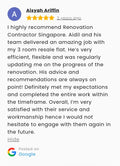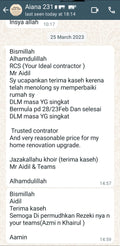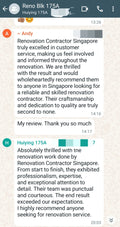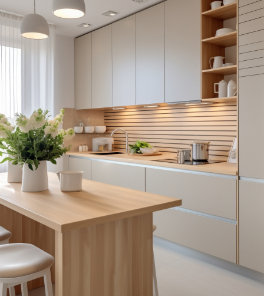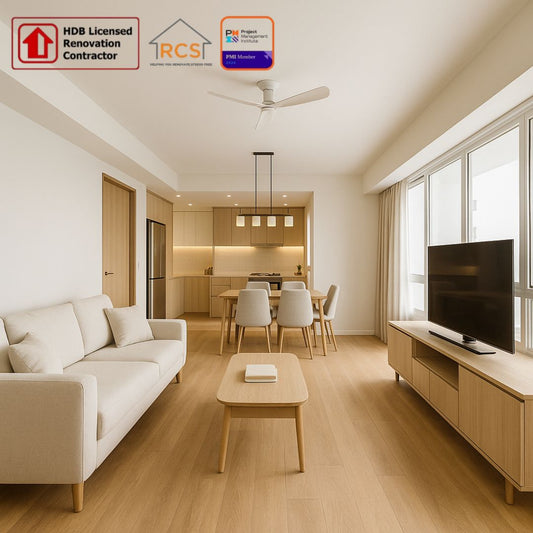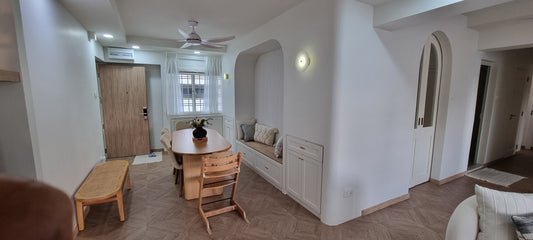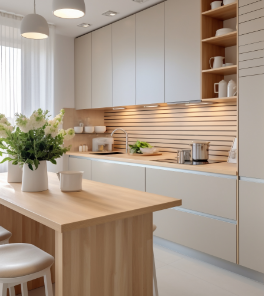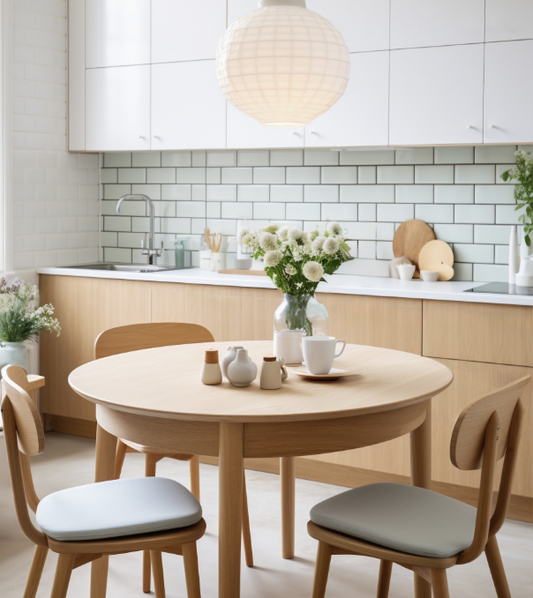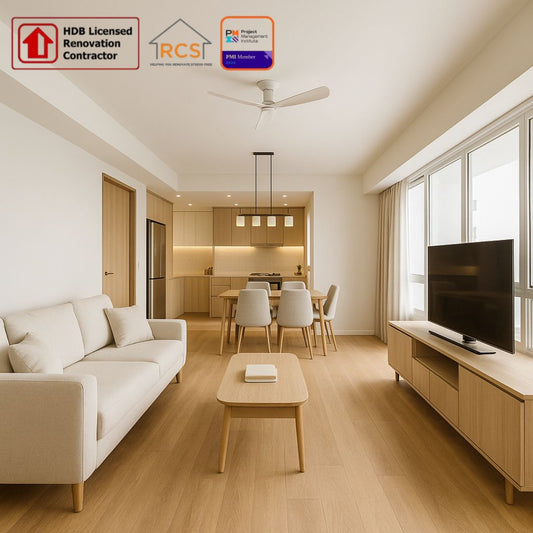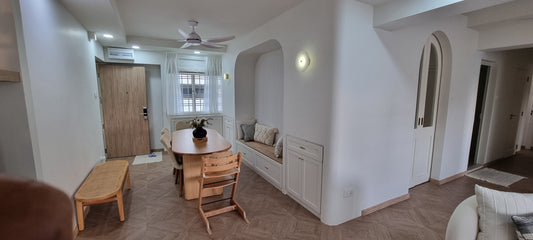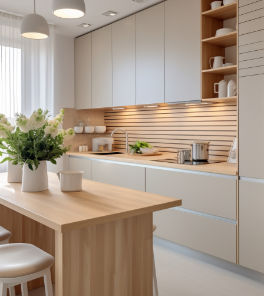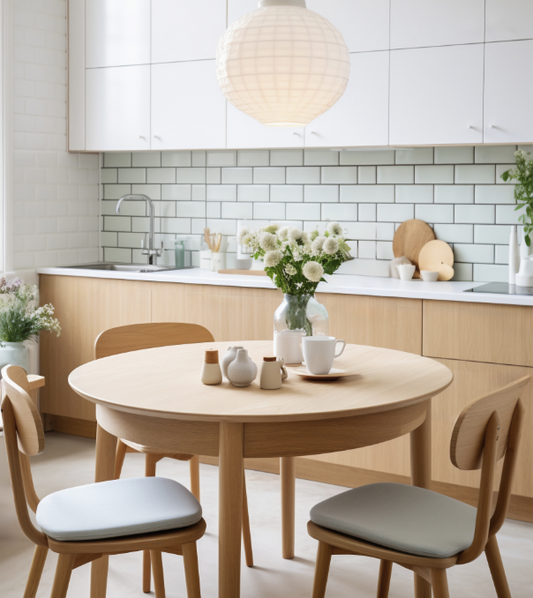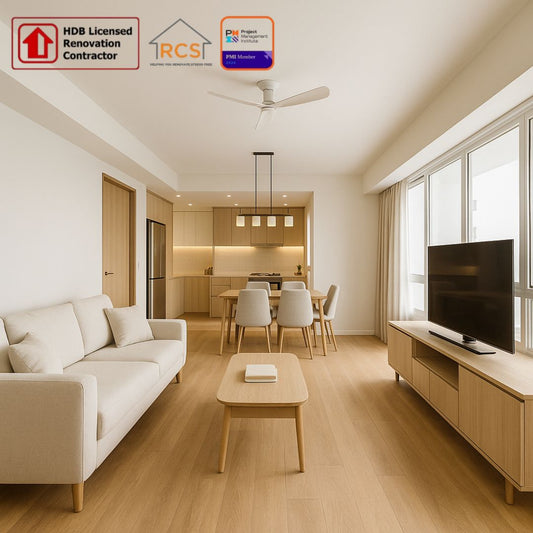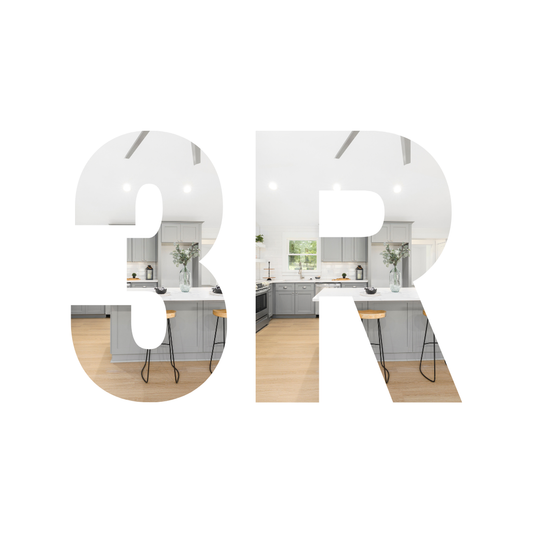Ready to transform your Singapore home through expert reno design? In 2025, clever renovation choices don't just create stunning spaces—they boost your property value and improve daily living. Yet most homeowners struggle with outdated ideas, wasting money on designs that quickly feel stale.
Your home deserves better. As Singapore's renovation landscape evolves, you need practical knowledge about current trends, realistic costs, and regulatory requirements. Why fumble through this complex process alone?
Our comprehensive reno design guide combines decades of experience with fresh creativity. From texture-rich walls to smart home integration, we'll guide you through every step of your renovation journey.
What Is Reno Design and Why It Matters in Singapore
Reno design encompasses the complete transformation of your living space through strategic planning, material selection, and aesthetic enhancement. In Singapore's competitive property market, thoughtful renovation design directly impacts your daily comfort, long-term happiness, and financial wellbeing.
The Singapore Advantage
Singapore's construction market reached SGD 18.53 billion in 2025, with steady growth forecast through 2029. This growth means your renovation investment likely appreciates alongside this booming sector. Properties with modern, well-executed reno designs typically command 5-15% higher resale values than market average.
Moreover, Singapore's push toward 80% green buildings by 2030 through the BCA Green Mark scheme positions sustainable renovation choices ahead of future regulations. Smart reno design choices today prevent costly modifications tomorrow.
Health and Wellness Benefits
Quality reno design improves indoor air quality through low-VOC materials and proper ventilation systems. With Singapore's tropical humidity, moisture management becomes crucial. Professional design prevents mold growth while creating healthier living environments.
Furthermore, biophilic design elements—incorporating natural materials and plants—reduce stress levels and improve mental health. Studies show homes with nature-inspired reno design reduce cortisol levels by up to 15%.
2025 Reno Design Trends Dominating Singapore Homes
1. Textured Surfaces with Warm, Muted Palettes
Textured surfaces like limewash, microcement, and clay finishes dominate 2025 reno design trends. These materials create depth without overwhelming compact Singapore spaces. Pair these textures with warm, earthy color schemes including beige, terracotta, and muted browns.
Professional interior designers report 40% increase in client requests for textured wall treatments. This shift from stark whites creates cozy sanctuaries away from Singapore's urban intensity.
2. Curved Elements and Organic Shapes
Sharp angles give way to softer, ergonomic forms in modern reno design. Arched doorways, rounded countertops, and furniture with gentle curves enhance safety while improving movement patterns through your home.
Industry experts note curved surfaces cost 20-30% more than straight edges. However, the ergonomic benefits and visual appeal justify this investment for most homeowners pursuing premium reno design.
3. Biophilic Design Integration
Singapore's tropical environment inspires today's most beautiful reno designs. Biophilic principles—incorporating nature through materials, plants, and light—dominate 2025 trends while improving indoor air quality and well-being.
Popular biophilic elements include living walls, natural stone surfaces, and abundant natural light. These features reduce energy costs while creating healthier living environments suited to Singapore's climate.
4. Smart Home Technology Integration
Technology seamlessly integrates into contemporary reno design rather than functioning as mere add-ons. Voice-controlled lighting, automated climate control, and integrated security systems enhance daily convenience while maintaining aesthetic appeal.
Smart home packages now start from S$1,500, making advanced technology accessible for most renovation budgets. The best implementations hide technical components within stylish fixtures complementing your overall design theme.
5. Multifunctional Spaces for Hybrid Living
With hybrid work models continuing in 2025, reno design must accommodate multiple uses throughout the day. Flexible zones replace single-purpose rooms through convertible furniture, modular systems, and clever storage solutions.
Modern reno design incorporates fold-away desks, expandable dining tables, and seating with hidden storage. These solutions maximize functionality without sacrificing style in Singapore's compact living spaces.
6. Sustainable Material Selection
Eco-friendly materials gain prominence in 2025 reno design. Low-formaldehyde plywood, engineered wood, and zero-VOC paints protect indoor air quality while supporting environmental responsibility.
Sustainable choices extend beyond health benefits. Energy-efficient fixtures reduce utility bills by 20-40% annually, while durable materials require less frequent replacement.
7. Japandi Aesthetic Influence
The fusion of Japanese minimalism with Scandinavian coziness creates serene living spaces perfect for Singapore's fast-paced lifestyle. Clean lines, natural materials, and neutral palettes characterize this trending reno design approach.
Japandi-inspired reno design emphasizes quality over quantity, featuring carefully selected pieces that serve both functional and aesthetic purposes. This philosophy aligns with Singapore's space-conscious living requirements.
Essential Reno Design Principles for Singapore Homes
1. Climate-Conscious Material Selection
Singapore's tropical humidity demands specific material considerations in reno design. Moisture-resistant finishes prevent mold growth, while heat-reflecting surfaces reduce cooling costs.
Successful reno design incorporates porcelain tiles for high-humidity areas, engineered wood for stability, and breathable wall finishes that handle moisture without compromising aesthetics.
2. Space Optimization Strategies
Effective reno design maximizes Singapore's limited space through vertical storage, built-in solutions, and multi-purpose furniture. Strategic mirror placement amplifies natural light while creating illusions of expanded space.
Professional space planning techniques include corner utilization, under-stair storage, and ceiling-height wardrobes. These approaches can increase usable space by 30% without structural modifications.
3. Lighting Design for Tropical Conditions
Singapore's abundant natural light requires careful management in reno design. Strategic window treatments maximize daylight while minimizing heat gain. Layered artificial lighting accommodates varying daily needs and tropical weather conditions.
Modern lighting design incorporates ambient, task, and accent lighting with smart controls. LED technology reduces energy consumption by 75% compared to traditional lighting while offering superior design flexibility.
4. Ventilation and Air Quality Management
Proper airflow becomes critical in Singapore's humid climate. Reno design must incorporate adequate ventilation systems, air purification technology, and moisture control measures.
Cross-ventilation design, strategic fan placement, and dehumidification systems maintain comfort while preventing indoor air quality issues common in tropical environments.
HDB vs. Condo Reno Design Considerations
HDB Renovation Design Requirements
HDB reno design must comply with specific regulations governing structural modifications, material choices, and renovation timelines. Understanding these requirements prevents costly delays and regulatory violations.
Key HDB considerations include:
- Mandatory use of HDB Directory of Renovation Contractors (DRC)
- Specific permit requirements for hacking works
- Renovation timing restrictions (weekdays 9AM-5PM for noisy work)
- Waterproofing requirements for resale flat bathrooms
- Floor loading limits for material selection
Condominium Design Flexibility
Condo reno design offers greater flexibility while requiring MCST approval for certain modifications. Private properties allow more extensive structural changes and premium material selections.
Condo-specific advantages include relaxed renovation timing, expanded contractor options, and freedom for luxury finishes that may exceed HDB guidelines.
BTO vs. Resale Renovation Strategies
New BTO units provide "blank canvas" opportunities for reno design, while resale properties often require extensive preliminary work. Understanding these differences affects budget allocation and timeline planning.
BTO reno design focuses on fresh installations without demolition costs. Resale renovations typically require 40% higher budgets due to hacking, disposal, and existing system updates.
Comprehensive Reno Design Process Guide
Phase 1: Vision Development and Planning
Successful reno design begins with clear vision definition. Create inspiration boards reflecting your lifestyle needs, aesthetic preferences, and functional requirements. This foundational step guides all subsequent decisions.
Professional planning includes space analysis, regulatory research, and budget establishment. Engage interior designers early to avoid costly modifications during construction phases.
Phase 2: Regulatory Approval and Permits
Singapore reno design requires various permits depending on scope and property type. HDB renovations demand specific approvals for structural modifications, while condo projects need MCST consent for certain works.
Permit processing typically requires 2-3 weeks. Submit applications early to prevent project delays. Your renovation contractor should handle permit coordination as part of comprehensive service packages.
Phase 3: Material Selection and Procurement
Quality materials define successful reno design outcomes. Singapore's climate demands moisture-resistant, durable selections that maintain appearance despite tropical conditions.
Popular material categories include:
- Engineered flooring: S$8-15 per sq ft
- Quartz countertops: S$45-80 per sq ft
- Premium tiles: S$8-14 per sq ft
- Low-VOC paints: S$25-40 per liter
- Custom carpentry: S$800-1,200 per linear foot
Phase 4: Construction Management
Professional project management ensures reno design implementation matches specifications. Regular site visits, quality control inspections, and timeline monitoring prevent common renovation problems.
Effective construction management includes material delivery coordination, trade sequencing, and client communication. Experienced contractors provide weekly progress reports with photographic documentation.
Phase 5: Final Inspection and Handover
Thorough final inspections verify reno design quality before handover. Professional contractors provide detailed checklists covering all installed elements, finishes, and system functionality.
Quality handover includes warranty documentation, maintenance instructions, and emergency contact information. Reputable firms offer 1-2 year warranties covering workmanship and materials.
Singapore Reno Design Cost Breakdown 2025
HDB BTO Renovation Costs
Average BTO reno design costs vary significantly based on flat size and finish quality:
- 3-Room BTO: S$34,200 - S$52,100
- 4-Room BTO: S$52,500 - S$66,000
- 5-Room BTO: S$62,000 - S$70,000
These figures represent complete renovations including kitchen, bathrooms, flooring, painting, and basic carpentry works. Premium finishes can increase costs by 30-50%.
HDB Resale Renovation Expenses
Resale flat reno design typically costs 40% more than BTO due to demolition requirements and system updates:
- 3-Room Resale: S$48,000 - S$73,000
- 4-Room Resale: S$64,300 - S$80,300
- 5-Room Resale: S$67,000 - S$92,600
Cost Distribution Analysis
Understanding expense allocation helps optimize reno design investments:
- Carpentry: 35-37% of total budget
- Masonry: 25% of total budget
- Electrical works: 8-10% of total budget
- Plumbing: 5-8% of total budget
- Hacking/demolition: 7% of total budget
- Painting: 5-7% of total budget
Premium Upgrade Considerations
Luxury reno design elements command premium pricing but offer enhanced durability and aesthetics:
- Marble surfaces: S$80-150 per sq ft
- Smart home systems: S$3,000-8,000
- Custom lighting design: S$2,000-5,000
- Built-in wardrobes: S$1,000-2,000 per linear foot
- Designer kitchen cabinets: S$15,000-35,000
Choosing the Right Reno Design Contractor
Essential Credentials Verification
Singapore reno design contractors must possess specific licenses and accreditations. Verify HDB Directory of Renovation Contractors (DRC) registration for all HDB projects. BCA licensing indicates capability for private properties and structural modifications.
CaseTrust accreditation provides consumer protection through standardized contracts, deposit safeguards, and dispute resolution mechanisms. This voluntary certification demonstrates commitment to professional service standards.
Portfolio Assessment Criteria
Evaluate contractor portfolios focusing on projects similar to your reno design requirements. Look for consistent quality across different project types and budgets. Request recent client references and actually contact them about their renovation experiences.
Pay attention to design versatility, problem-solving capabilities, and attention to detail in completed projects. Quality contractors showcase both aesthetic achievements and functional improvements.
Communication and Service Standards
Professional reno design contractors demonstrate excellent communication throughout the engagement process. Responsive inquiry handling, clear technical explanations, and transparent pricing indicate service quality.
Evaluate project management capabilities through detailed proposals, realistic timelines, and comprehensive quotations. Quality contractors provide itemized breakdowns rather than vague estimates.
Warranty and After-Sales Support
Reputable contractors offer comprehensive warranties covering workmanship defects and material failures. Standard warranty periods range from 1-2 years depending on scope and materials used.
After-sales support includes maintenance guidance, emergency response, and periodic check-ups. Quality contractors maintain long-term relationships rather than disappearing after project completion.
Smart Storage Solutions in Reno Design
Maximizing Vertical Space
Singapore's compact living demands creative storage integration within reno design. Ceiling-height wardrobes, wall-mounted cabinets, and vertical shelving systems dramatically increase storage capacity without consuming floor space.
Modern storage solutions include pull-down mechanisms for high shelves, sliding systems for corner access, and modular components accommodating changing needs over time.
Hidden Storage Integration
Sophisticated reno design incorporates invisible storage maintaining clean aesthetics. Under-stair compartments, bed platform storage, and hollow furniture provide substantial capacity while preserving visual appeal.
Hidden storage costs 20-30% more than conventional solutions but significantly enhances living space functionality and property value.
Multi-Purpose Furniture Selection
Flexible furniture supports Singapore's space-conscious reno design requirements. Ottoman storage, extendable dining tables, and convertible study desks serve multiple functions while conserving space.
Quality multi-purpose pieces cost 1.5-2x single-function alternatives but eliminate need for additional furniture while supporting flexible living arrangements.
Sustainable Reno Design Practices
Eco-Friendly Material Selection
Sustainable reno design incorporates responsibly sourced materials with minimal environmental impact. Low-formaldehyde plywood, recycled metal fixtures, and rapidly renewable bamboo flooring support ecological responsibility.
These materials often cost 10-20% more initially but provide superior durability and healthier indoor environments. Long-term value includes reduced replacement needs and improved air quality.
Energy Efficiency Integration
Smart reno design incorporates energy-saving technologies reducing long-term operating costs. LED lighting, efficient appliances, and improved insulation can reduce energy consumption by 30-50%.
Initial investment in energy-efficient systems typically pays back within 3-5 years through reduced utility bills while supporting Singapore's sustainability goals.
Water Conservation Features
Water-efficient fixtures complement sustainable reno design objectives. Low-flow taps, dual-flush toilets, and greywater systems reduce consumption while maintaining functionality.
These features support Singapore's water sustainability initiatives while reducing household utility expenses over time.
Common Reno Design Mistakes to Avoid
Inadequate Planning and Budgeting
Rushing into reno design without comprehensive planning leads to cost overruns and disappointing results. Allocate 10-20% contingency budget for unexpected issues, especially in resale properties.
Poor planning includes insufficient electrical capacity for modern appliances, inadequate storage provision, and material selections unsuitable for Singapore's climate.
Ignoring Regulatory Requirements
Singapore reno design must comply with specific regulations. Unauthorized modifications can result in fines up to S$5,000 and forced rectification at owner expense.
Common violations include structural modifications without permits, non-compliant window installations, and unauthorized external painting. Always verify requirements before proceeding.
Prioritizing Aesthetics Over Functionality
Successful reno design balances visual appeal with practical functionality. Beautiful designs that don't support daily living needs quickly become sources of frustration.
Consider maintenance requirements, cleaning accessibility, and long-term durability when making aesthetic choices. Pretty designs requiring constant upkeep rarely satisfy long-term.
Inadequate Ventilation Planning
Singapore's humid climate demands proper airflow consideration in reno design. Insufficient ventilation leads to mold growth, musty odors, and indoor air quality problems.
Ensure adequate exhaust systems in bathrooms and kitchens, maintain cross-ventilation paths, and consider mechanical ventilation for enclosed spaces.
Technology Integration in Modern Reno Design
Smart Lighting Systems
Intelligent lighting enhances reno design functionality through automated controls, color temperature adjustment, and energy monitoring. Smart systems reduce electricity consumption while improving daily convenience.
Popular features include motion sensors, daylight integration, and smartphone controls. Installation costs range S$500-2,000 depending on complexity and coverage area.
Home Automation Platforms
Comprehensive automation systems integrate various home functions through centralized control. Temperature regulation, security monitoring, and entertainment systems operate seamlessly through unified interfaces.
Entry-level automation packages start around S$1,500, while comprehensive systems can exceed S$8,000. Choose scalable platforms allowing future expansion as needs evolve.
Security Technology Integration
Modern reno design incorporates advanced security features including smart locks, video doorbells, and surveillance systems. These technologies enhance safety while supporting contemporary aesthetic requirements.
Wireless systems simplify installation without extensive rewiring, making them ideal for renovation projects. Cloud storage and smartphone access provide convenient monitoring capabilities.
Future-Proofing Your Reno Design Investment
Adaptable Space Planning
Smart reno design anticipates changing family needs through flexible space configurations. Growing families, aging residents, and evolving work patterns require adaptable environments.
Design features supporting adaptability include removable partitions, reinforced walls for future modifications, and electrical systems accommodating technology upgrades.
Universal Design Principles
Incorporating accessibility features during initial reno design prevents costly retrofitting later. Wider doorways, grab bar reinforcement, and level thresholds support aging-in-place strategies.
Universal design costs minimal additional expense during construction but provides substantial value for long-term livability and property marketability.
Technology Infrastructure Planning
Future-ready reno design includes comprehensive wiring for evolving technology needs. Additional electrical capacity, network infrastructure, and cable management support emerging smart home requirements.
Investing in robust infrastructure during renovation prevents costly retrofitting as technology advances and household needs evolve.
Frequently Asked Questions About Singapore Reno Design
How much does a complete HDB renovation cost in 2025?
Complete HDB reno design costs range S$34,200-S$52,100 for 3-room BTO flats to S$67,000-S$92,600 for 5-room resale units. Actual costs depend on material selections, scope complexity, and finish quality preferences.
What renovation works require HDB permits?
HDB permits are mandatory for hacking non-load-bearing walls, replacing wall/floor finishes, relocating internal doors, plumbing alterations, and window grille installations. Permit processing typically requires 2-3 weeks.
How long does a complete renovation take in Singapore?
Most renovations require 8-14 weeks for construction, plus 4-5 weeks for planning and permitting. Start engaging designers 2-3 months before anticipated move-in dates to ensure adequate preparation time.
Can I renovate my HDB flat myself?
While minor cosmetic changes are permitted, significant renovations require HDB-registered contractors. DIY work risks regulatory violations and potential structural damage. Professional contractors ensure compliance and quality.
What's the difference between BTO and resale renovation packages?
BTO packages focus on new installations without demolition, while resale packages include hacking, disposal, plumbing updates, and electrical rewiring. This explains their significant price difference of typically 40% higher for resale.
How do I choose between an interior designer and contractor?
Interior designers provide comprehensive planning and management but charge design fees (S$2,000-S$10,000). Contractors execute plans at lower costs but require more homeowner involvement in design decisions.
What are the most popular renovation styles in Singapore for 2025?
Leading trends include textured surfaces with warm palettes, curved elements, biophilic design, smart home integration, and multifunctional spaces. These styles balance aesthetics with practical functionality for Singapore living.
How much should I budget for contingencies?
Reserve 10-20% of total budget for contingencies. Unforeseen issues like hidden plumbing problems or electrical updates frequently arise, especially in older properties. This buffer prevents project delays and financial stress.
Are sustainable materials worth the extra cost?
Sustainable materials typically cost 10-20% more initially but provide superior durability, healthier indoor environments, and reduced long-term replacement needs. Energy-efficient features also reduce utility bills over time.
What's the best time of year to renovate in Singapore?
Singapore's consistent climate allows year-round renovation. However, avoid peak holiday periods (December-January, Chinese New Year) when contractor availability and material prices may be affected. Plan around your personal schedule and budget cycles.
Transform Your Space with Expert Reno Design
Don't settle for mediocre results when exceptional reno design lies within reach. Professional renovation transforms your Singapore home into a functional, beautiful space reflecting your unique lifestyle while maximizing property value.
Ready to begin your renovation journey? Contact our experienced team for personalized consultation and transparent pricing. We'll help you navigate Singapore's complex renovation landscape while delivering stunning results that exceed expectations.
Your dream home awaits. Let's make it happen together through thoughtful, professional reno design that stands the test of time.





